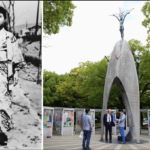
Remembering Hiroshima & Nagasaki for a Nuclear-Free Future
On August 6th and 9th, 1945, the United States detonated two atomic bombs over the Japanese cities of Hiroshima and Nagasaki, respectively. The aerial bombings together killed between 129,000 and 226,000 people, most of whom were civilians, and remain the only use of nuclear weapons in an armed conflict.
“The two atomic bombs dropped on Japan in 1945 killed and maimed hundreds of thousands of people, and their effects are still being felt today.
Learn more at icanw.org/hiroshima_and_nagasaki_bombings
The uranium bomb detonated over Hiroshima on 6 August 1945 had an explosive yield equal to 15,000 tonnes of TNT. It razed and burnt around 70 per cent of all buildings and caused an estimated 140,000 deaths by the end of 1945, along with increased rates of cancer and chronic disease among the survivors.
A slightly larger plutonium bomb exploded over Nagasaki three days later levelled 6.7 sq km. of the city and killed 74,000 people by the end of 1945. Ground temperatures reached 4,000°C and radioactive rain poured down.
[…] The Hibakusha (survivors of the bombings of Hiroshima and Nagasaki) are integral to the history of the atomic bombings of these cities – not only because they are among the few true nuclear weapons experts to have experienced the actual impact of these weapons – but also because of the tireless efforts of many Hibakusha to eliminate nuclear weapons.
From the iconic story of Sadako’s 1000 paper cranes to the tireless efforts by Hibakusha to rid the world of nuclear weapons to this very day, their stories are stories of hope and determination that must not be lost. Survivors of the atomic bombings of Hiroshima and Nagasaki are living witnesses to the horror of nuclear war and when we talk about nuclear weapons, we must talk about the real unacceptable effects they have on human beings.”
